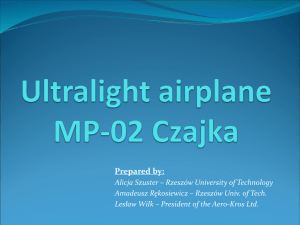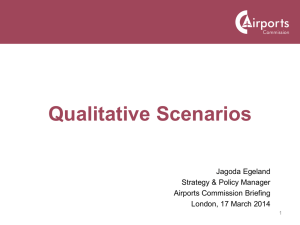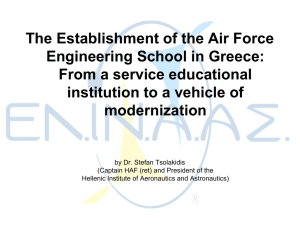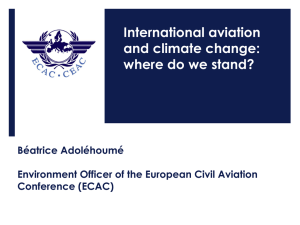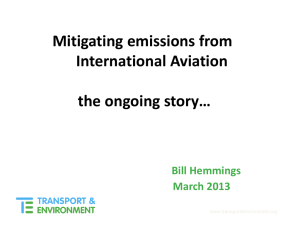Aviation and its impacts on the Global Atmosphere
advertisement
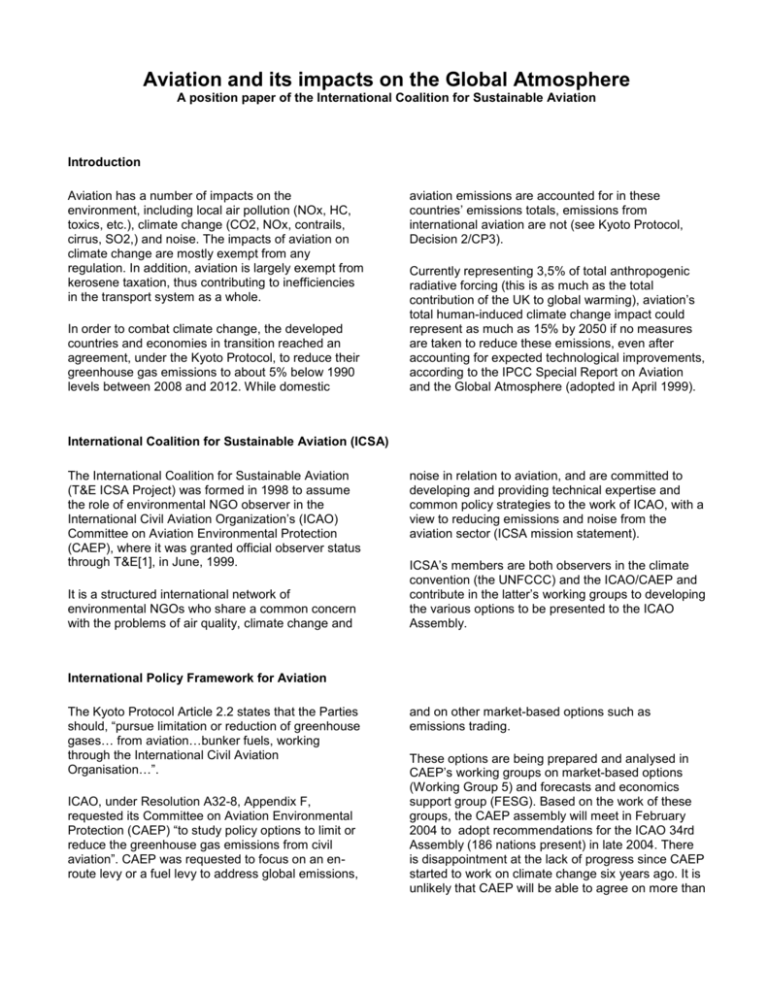
Aviation and its impacts on the Global Atmosphere A position paper of the International Coalition for Sustainable Aviation Introduction Aviation has a number of impacts on the environment, including local air pollution (NOx, HC, toxics, etc.), climate change (CO2, NOx, contrails, cirrus, SO2,) and noise. The impacts of aviation on climate change are mostly exempt from any regulation. In addition, aviation is largely exempt from kerosene taxation, thus contributing to inefficiencies in the transport system as a whole. In order to combat climate change, the developed countries and economies in transition reached an agreement, under the Kyoto Protocol, to reduce their greenhouse gas emissions to about 5% below 1990 levels between 2008 and 2012. While domestic aviation emissions are accounted for in these countries’ emissions totals, emissions from international aviation are not (see Kyoto Protocol, Decision 2/CP3). Currently representing 3,5% of total anthropogenic radiative forcing (this is as much as the total contribution of the UK to global warming), aviation’s total human-induced climate change impact could represent as much as 15% by 2050 if no measures are taken to reduce these emissions, even after accounting for expected technological improvements, according to the IPCC Special Report on Aviation and the Global Atmosphere (adopted in April 1999). International Coalition for Sustainable Aviation (ICSA) The International Coalition for Sustainable Aviation (T&E ICSA Project) was formed in 1998 to assume the role of environmental NGO observer in the International Civil Aviation Organization’s (ICAO) Committee on Aviation Environmental Protection (CAEP), where it was granted official observer status through T&E[1], in June, 1999. It is a structured international network of environmental NGOs who share a common concern with the problems of air quality, climate change and noise in relation to aviation, and are committed to developing and providing technical expertise and common policy strategies to the work of ICAO, with a view to reducing emissions and noise from the aviation sector (ICSA mission statement). ICSA’s members are both observers in the climate convention (the UNFCCC) and the ICAO/CAEP and contribute in the latter’s working groups to developing the various options to be presented to the ICAO Assembly. International Policy Framework for Aviation The Kyoto Protocol Article 2.2 states that the Parties should, “pursue limitation or reduction of greenhouse gases… from aviation…bunker fuels, working through the International Civil Aviation Organisation…”. ICAO, under Resolution A32-8, Appendix F, requested its Committee on Aviation Environmental Protection (CAEP) “to study policy options to limit or reduce the greenhouse gas emissions from civil aviation”. CAEP was requested to focus on an enroute levy or a fuel levy to address global emissions, and on other market-based options such as emissions trading. These options are being prepared and analysed in CAEP’s working groups on market-based options (Working Group 5) and forecasts and economics support group (FESG). Based on the work of these groups, the CAEP assembly will meet in February 2004 to adopt recommendations for the ICAO 34rd Assembly (186 nations present) in late 2004. There is disappointment at the lack of progress since CAEP started to work on climate change six years ago. It is unlikely that CAEP will be able to agree on more than further studies and discussions, atl east in the next three years. Parallel to the ICAO process, the Conference of the Parties to the United Nations Framework Convention on Climate Change and its subsidiary bodies working on mechanisms for the implementation of the Kyoto Protocol and for a regime beyond the budget period for 2008-12. These processes are crucial for developing measures to limit or reduce emissions from international aviation. Bearing this is mind, it is important to note the following in assessing the effectiveness and applicability of the measures envisaged: CAEP is focusing on market-based options rather than looking at all the possible control measures, which would be needed to achieve the environmental goal, e.g. policies and measures to promote modal shift. CAEP’s market instruments are only focusing on CO2 emissions; however, emissions from aviation differ from those emitted on the ground in that they are emitted directly in the higher atmosphere and thus have a higher global warming potential: the total global warming potential of aviation is thus three times that of CO2 alone. It is very unlikely that ICAO members will approve any measures that have a global rather than only developed countries application in the first budget period (2008-2012). World’s major industrialised nations are both members in ICAO and have agreed under the Kyoto Protocol to reduce their emissions by 5% between 2008-2012. The question of allocation of international emissions is still unresolved, so that countries do not have a clear responsibility for their contribution. ICSA Position2 ICSA strongly advocates that measures to reduce emissions from aviation should be developed and implemented as soon as possible, as outlined below. ICAO should decide at its 34rd Assembly to implement an emissions levy and/or an emissions trading system that would reduce international aviation greenhouse gas emissions from all Annex I Parties by 5% below 1990 levels by 2008-2012; if no appropriate solutions are decided by the ICAO Assembly, then the task should be given to the UNFCCC to decide on a work and immediate implementation plan for international aviation emissions. If ICAO fails to take appropriate and sufficient actions to address international aviation greenhouse gas emissions at its 34rd Assembly, the Conference of the Parties (COP) and its subsidiary bodies should work expeditiously to resolve the issue of allocation; this would ensure that in the absence of adequate measures developed by ICAO, the Parties to the climate convention can decide to include these emissions in their first budget periods. All measures envisaged to control aviation emissions should take into account the whole global warming effects of aviation and not just CO2. The reduction target for aviation emissions needs to be expressed in absolute reductions (i.e. absolute tonnage goals, rather than ratebased targets). A package of measures, such as policies and measures aimed at: modal shift, new technologies, non-technical measures for reducing demand for travel, should simultaneously be developed and implemented by developed nations. Any market-based system must be environmentally sound with strong monitoring and compliance mechanisms in place prior to its implementation. SBSTA should renew its efforts to resolve the issue of allocation of emissions from bunker fuels. ICSA, December 2003 -------------------------------------------------------------------------------[1] T&E is the European Federation for Transport and Environment. Formed in 1989 it is a network of about 40 organisations working in the field of transport and environment. See the T&E website: http://www.t-e.nu. [2] ICSA has developed detailed position papers on emissions trading, levies and noise from aviation that are available from the ICSA members (Contact: Karsten Krause c/o T&E ICSA, Tel/Fax +32-2- 502 99 09 / 08, E-mail: karsten.krause@t-e.nu).



